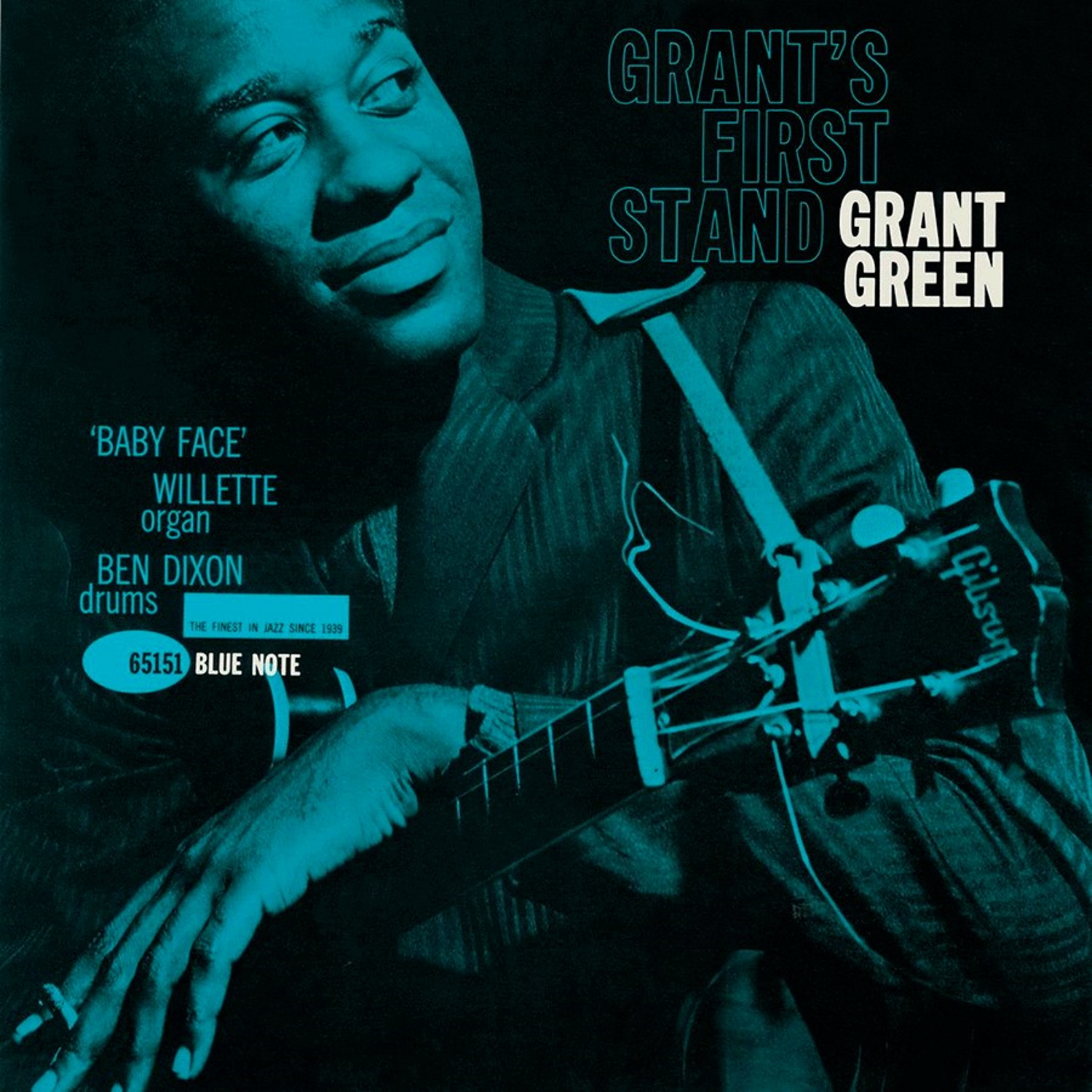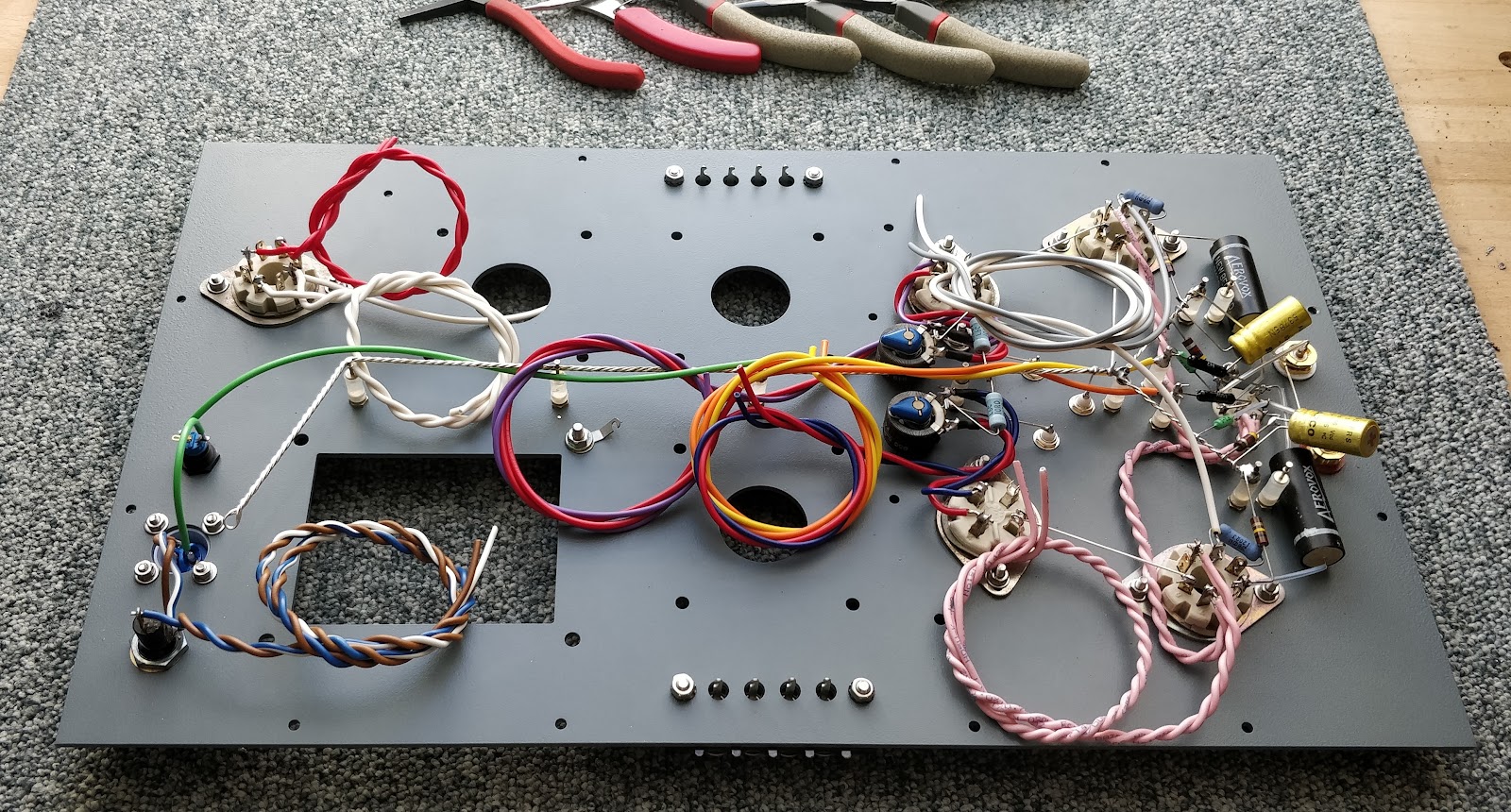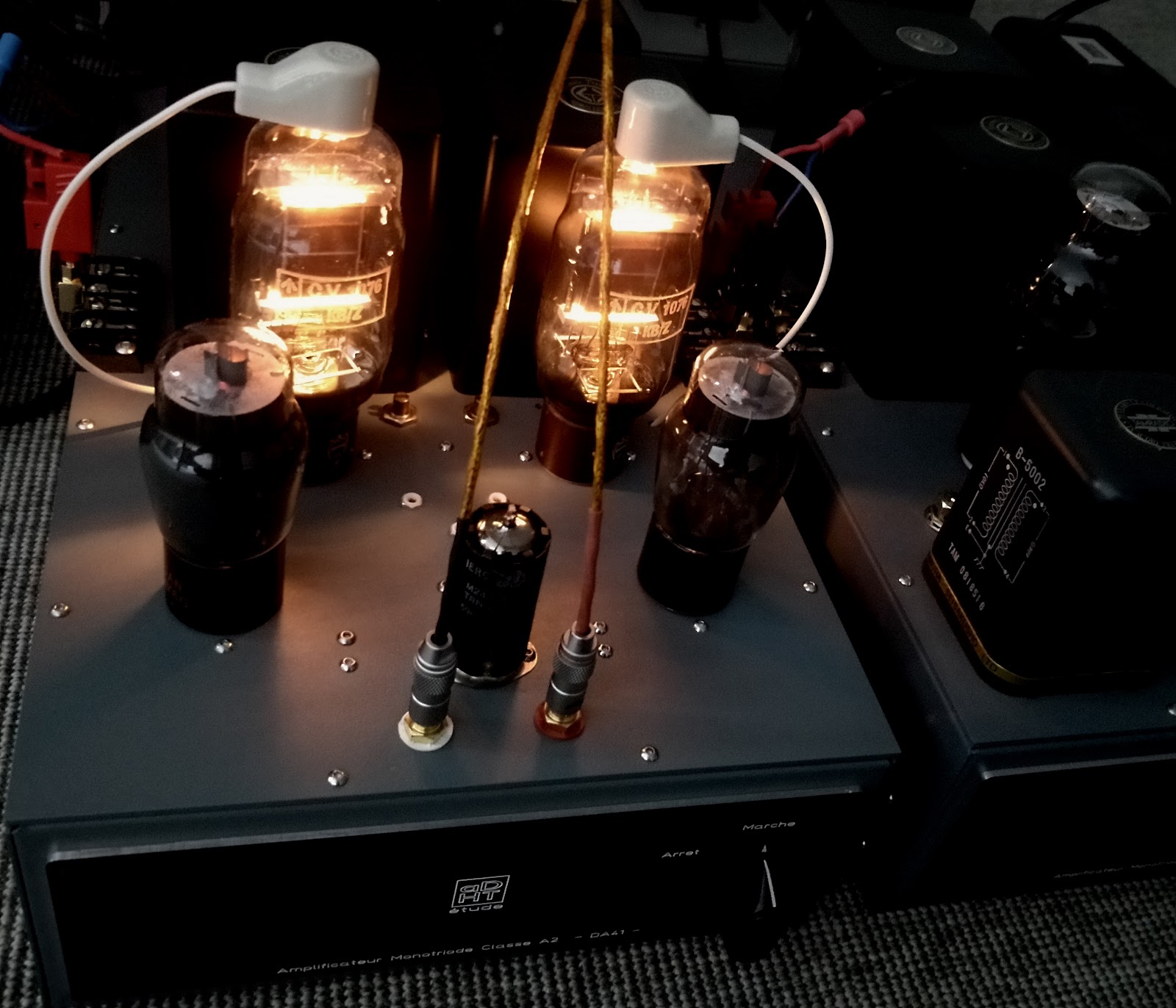...SOLD...
Power supply
My long time favorite for smooth filtering is a LC supply. Not only the mains residual is almost a perfect sine wave, but transients response is better than with a capacitor input. With a large choke value, ripple can be very low. However, to keep first cell time constant around 15mS, the total series resistance must remains low. A well wound power transformer and equally good choke are mandatory. For that purpose, I use top quality Hashimoto’s irons for more than a decade with total satisfaction.
A first cell (25H/50µF) will reduce ripple to Vripple = Vout / 6π2 f2 LC √2, a second one (180 ohm/100µF) will floor down residual to negligible value.
Some voltage adjustment being necessary on CF anode to precisely set DA41 grid current, I splitted supply in two after the second cell. One arm to the 6K6/6V6, the second to the 6CG7.
Making of
Aluminum CNC chassis, epoxy coated, plus a few components



Amplifier completed, ready for measurements and listening test. It's a beefy unit weighing almost 40 pounds.
DA41 bright light is a pure enjoyment in the dark
Test setup. Max power, 100Hz_10KHz squares and THD
7,8 Vrms/8 ohm at clipping, 7,6W as expected

Despite a 18/20Kohm internal resistance the DA41 adapts quite well to the output transformer and low end roll off is not so obvious during listening test
Short reminder: transformer primary inductance has a direct effect on the low frequency response. The -3dB low frequency cutoff is determined by
Where Z is the primary impedance (reflected impedance in parallel with the tube internal resistance) and L the primary inductance. For a 5Kohm reflected load and 23H@70mA inductance (Hashimoto H20-7U)
THD: 2,76% @ 1Watt, 6,06% @ 5 Watt. Nice harmonics distribution, mainly H2
I tried a close loop feedback between DA41 anode and 6K6/6V6 grid to get a flatter 100Hz square signal and it was disappointing. Sound became muddy, loosing all the life music could bring. Regardless of apparent poor scope results or distortion I prefer, by far, the amplifier without feedback. We must not lose sight that there is little to none relation between music, which is more in the transients domain, and squares.
Reason why it’s of prime importance to calculate accurately all time constants including power supply to respect signal ADSR.
Listening report
Garrard 301, FR24, Entré EC30, C3g phono preamplifier, 6J5 line preamplifier
On my homebrewed Klipsch Altec system the 6V6 gives the best balance with a great sense of refinement and a silky smooth sound. Each record I spin on my Garrard plays with ease and life. Dynamic is excellent, nervous or soft depending upon music. I love the way a trumpet or a sax is rendered and human voices are really addictive. Low end is firm, ample with a convincing restitution even if it doesn't extend deeply. Music is played without the somewhat harshness heard with transmitting triodes like 809 or 811. It was easy to make a comparison, the PT260 transformer can supply 6,3 or 7,5V. Is it the fact the DA41 was developed as a pure audio tube or the materials used to build it, I couldn’t say. Anyway the GEC sounds much more natural and involving than its counterparts and it blends very well with a 6V6 (Mazda or Westinghouse). The 6K6 is surprisingly more punchy with deeper bass extension, but restitution appears less natural with a forward presentation and could be a better choice on Rock music.
I am somewhat confused and surprised. To this day I don’t know which of the Visseaux A710 or the GEC DA41 is the best of my amplifiers. In any case I listen to both with great pleasure and that’s the most important. Music, music toujours…




























What I can say, I would be trembling having no possibility of self listening :)
ReplyDeleteIt is very interesting, at least from my side if majority of THD comes from driver or output tube itself, as figure is quite high and we are having grid current operation here.
Don't you feel a difference between DA42 and A710, as they have a damping factor relation like 1:4? This was also bothering me when thinking about this tube.
Do you know about any possible stock of DA41, as I am having only DA42s. Hard to distinguish the difference by heater only, not listening both.
Hi Bartek, most of distortion comes from buffer stage, I understand it appears quite high but listening test contradicts totally measures. I brought this amp to Jean Hiraga and listened on his huge system, the audience was surprised how clean and clear it could sing.
DeleteI have no opinion about DA42, a tube I don't have. You can source some nice TZ40 which is a direct drop in. I listened to both and difference is very subtle...if there is one.
About the A710 I considered it a reference by which others are compared, I just have to say that I play daily the DA41 and it's pure enjoyment. I didn't light up the A710 for more than 3 months.
Hope this helps
I think you could source some DA41 from Billington England
DeleteThank you for this tip with Billington, I forgot to check there. When arrive I will share my measurements result with you on the HW-40-5. Can't stand waiting to be honest :)
ReplyDeleteYou should have lower THD with a push pull. This setup cancels odd distortion
DeleteYes, from simulations based on the 811A(quite similar), where I have characteristics, in PP @ 700V and 55mA of bias, with four tubes PP parallel I am having less then 1% of H3 @ 30W. This would give load plate to plate per pair @ >20k considering DC resistance of primary. Two tubes with load of 10k is giving around 2% of H3, which is not acceptable. One pair shall have input resistance of 3k like you mentioned(even 3.2k according DS), so two goes down to 1.5k, which is still within the limit of my pre. Based on your insights here about this tubes I really want to try this setup. Rig was already tested on 829A, where I have a very good distortion results, however I really doubt these tubes will ever get close to DA41. All in Billington hands now :)
DeleteHi Bartek, I will follow your work with lots of interest. Fred
DeleteFred--
ReplyDeleteWhat a wonderful blog. Thanks for sharing everything that you do.
Was wondering if you have ever pursued regulated supplies for DHT filaments. Also, what about LC power supplies for filaments? Have you tried that?
Hi and thanks for your comment. I didn't try any filament supply regulation but it's worth trying to see ( hear ) if there is any difference. I used a LC filament supply with the MC1/60 tube with good results. For that purpose I ordered a custom made transformer. I can't do that with the stock Hashimoto's.
ReplyDeleteHave personally tried two regulated solutions: Pete Millett's DC supply and Rod Coleman's. I do not have extremely sensitive speakers, nor is my system up to par with yours, so cannot definitively say that there is a difference between either. Have also never listened to a 2A3 or 45 SE amplifier where the filaments we're supplied with AC.
DeleteAs I understand it, the difference between your rectified CR or CL filtered filament supplies and a regulated ces down to impedance of the supply (very small with regulation; with your setups, also probably quite small, but orders of magnitude larger than regulated) and the ripple present in the supply. According to Rod, his is down to: "7µA rms 20-20kHz (1.2A heating)."
Based on my so-so experience with these DIY PCB approaches, but excellent perceived results, would be very curious to know what your seasoned and experienced ear would hear (if anything) from trying a regulated approach.
LC for a filament supply seems so natural to me (high current; avoid large and/or rapid charging pulses; more protection against mains variance; fewer harmonics in the rectified waveform; etc) but I never see anyone trying it or even talking about it.
If choke input we're, in your opinion, just as good, I'd pursue that and avoid having to deal with heatsinking and all the annoyingly tiny mistakes/problems that can crop up with PCBs that one does not experience when working with larger discrete components.
Sorry my name is showing up as &. Am writing this on my phone. My name is Kyle. Thanks again and I look forward to any future posts. Also, appreciate you showing albums you listen to. Have been listening to Sonny Stitt recently after seeing him here!
Hi Kyle, thanks for this comment. I have a new amp on the bench using the 2E22. Could be a good idea to test a filament regulated supply, at least on one channel, and perform some mono listening test in addition to FFT measurements. If it's better sounding I'll let you know.
ReplyDeleteI used a LC filter with the MC1/60 because these triodes draw a lot of current. It's mandatory if you want to use a not to big choke. Main advantage is an almost sinusoidal ripple, easy to filter with a second cell, and a good voltage regulation. You can see the implementation under chassis of a Hammond choke along with three blue electrolytics.
Regards
Fred
Interesting finding from my side. As I after many measurements I finally gave up on these DA 42 tubes and came with an idea to use them as rectifiers, as having a lot of them, they look great and hopefully having a sonic impact as your DA 41 here :)
ReplyDeleteHowever I found them to be almost identical on the I/V plate characteristic as 5R4 with slight more 20R consistent higher resistance up to 45mA, where is a maximum grid dissipation based on the calcs, grid tied to plate. Tied to cathode giving a large internal resistance, consistent with normal output I/V characteristic of a triode usage. Cathode connected to heater, as having no idea about maximum permissible voltage in between.
Measurements averaged from four tubes today:
20mA 11.01V drop
30mA 15.02V drop
35mA 16.51V drop
40mA 17.84V drop
45mA 19.50V drop
Grid current ratio is consistently 0.25% of total over whole measured spectrum, giving around 1.6kR of impedance as expected.
I will be using them in the next project for voltage stage rectification, we will see how they sound :)
PS. I am using always a symmetrical LC filter, so L is located also on the return path between capacitors. I am using this configuration for filaments of big DHT with wonderful results for years. Just finished recently another GM70 SET with ISO tango OPT with this filament configuration. Measured noise floor at the output is 200uV @ 100Hz, absolutely not hearable. Sounds amazing like GM70 always do. This one is driven with EL3N triode strapped with IT Hashimoto A-105.
Hi Bartek, nice to hear from you. It's a seldom seen approach using power triodes like rectifiers. I know someone doing the same with 211 tubes. Will be interested by future developments and appreciate you'll share your experiments.
ReplyDeleteFred
Hi Fred.
ReplyDeleteInspiring build and write up. Thanks for sharing all your hard work. You restore a little faith in humanity with your generosity. I am Going to build a vertical version of this amp. (to look cool!!) I intend to try a higher impedance output transformer, at 400v and I would like to use an 807 (internally identical to 6l6) for the cathode follower as the top cap will aesthetically match the big triode. Any thoughts on 807 in this position?
Hi Nick, thanks for your comment and interest. This is a great sounding triode and I guess you will appreciate this amp as I do. I think the 807 tubes can be good contenders but I quick calculation gives a higher output impedance at about 190/200 ohm and with such unusual setup, the lower the better. You have to make a try and see if this tube can fully drive the DA41.
Delete